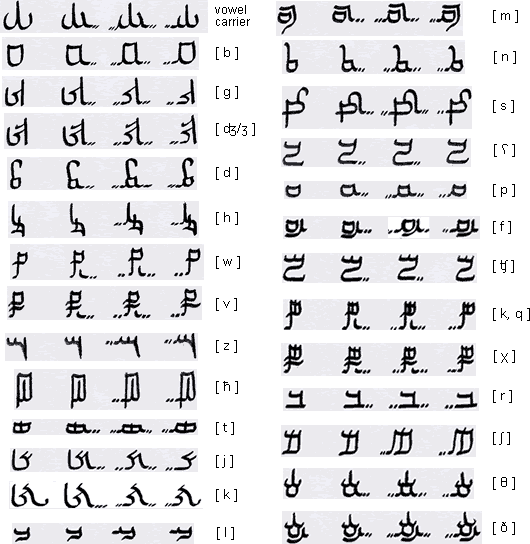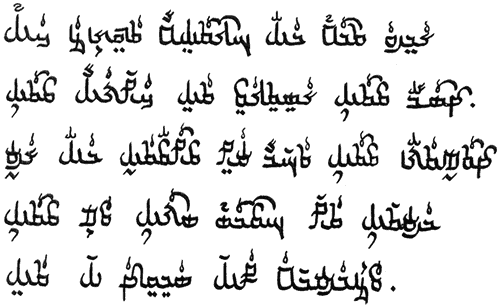Dameshon A 
Dameshon A was created by a visitor to Omniglot, who was inspired
by a long-standing interest in and esthetic appreciation for the
appearance of various forms of the Hebrew, Arabic, Phoenecian,
Mandaic, Aramaic alphabets, as well as the Tibetan script. Elements
of each of these may be recognized in the various letter-forms employed.
Dameshon A can be used to represent the sounds of the English
language, though not necessarily in as complete and scientifically
exact a manner as IPA. With some slight modification, it can also
be used to write Hebrew or other Semitic languages.
Notable features
- Dameshon A is written from left to right.
- Dameshon A is an Abugida in which all the letters have, as an
inherent vowel, the sound [ə] as in full. Diacritics are
added below or above the letters to change vocalization as needed.
There is also a symbol indicating absence of a vowel, so that
consonantal clusters may be represented. - The order of the letters as well as their phonetic value is very
similar though not identical to that found in the Hebrew Aleph-Bet. - When vowels appear at the beginning of a word or on their own,
a special vowel carrier is used. - Some of the consonants change shape when connected to other letters,
while others can only be connected to letters that precede them, and
others only to letters that follow them. - The first letter pronounced [k] is not used at the end of words.
Instead the second [k] is used.
Dameshon A consonants

Dameshon A vowel diacritics

Notes
- The vowel diacritics are placed above the consonants, except for
those pronounced [æ], [ɛ], [ɪ], [uː] and [eɪ]. - The consonants pronounced [h], [z], [l], [f] and [ð] always
have their vowels diacritics placed above them, and the vowel diacritics
appear above [m] when it occurs at the end of a word.
Sample text in Dameshon A

Transliteration
All human beings are born free and equal in dignity and rights. They
are endowed with reason and conscience and should act towards one another
in a spirit of brotherhood.
(Article 1 of the Universal Declaration of Human Rights)
